
The original structure that still contains the Petersen Automotive Museum was designed by Welton Becket Associates, creators of many Los Angeles architectural icons including the art deco classic Pan Pacific Auditorium, the Capital Records building, the LAX theme building, and the Dorothy Chandler Pavilion in the city’s Music Center.
The firm was commissioned to create a modernist, international style building at the corner of Wilshire and Fairfax for a Japanese Seibu Department Store in 1962, The store was not a success. Three years later the Miracle Mile building reopened as Orbachs Department Store that occupied the building until 1986 after which time it was unoccupied for six years.
Robert E. Petersen of the famous enthusiast publishing empire purchased the property for its exotic Wilshire face, well-engineered structure and windowless exterior as a final home for his Petersen Automotive Museum collection, founded on June 11, 1994, some of which had been exhibited — curiously — in Natural History Museum of Los Angeles County.
Petersen was a publishing visionary, but far more than the paper and ink concept was his ability to bring the absolutely correct character and intellect into his team exactly where he could best use what that individual could contribute — or be inspired to contribute to his vision.
When Leslie Kendall was asked to assume the responsibility of curating Petersen’s garage-full-of-cars-he-loved and to develop it into a public museum collection that had to represent our enthusiasm-driven hobby — lifestyle — he was tasked with drafting that vision as a permanent mission statement. The words he used have never been altered and continue to lead the growing number of personal collections that try to follow the public responsibility he so eloquently described:
“Unlike individual enthusiasts who acquire cars for personal reasons, a museum exists to collect, preserve and interpret in a way that speaks directly to a stated mission that transcends the tastes and preferences of a single individual.”

Now, with a new landmark Museum Row face on Becket’s historic Miracle Mile structure, Kendall wants to raise the bar on the Petersen Automotive Museum’s already comprehensive catalog of automotive design icons. He offered his collecting challenge to a spell-bound group of museum members and journalists who might reach a sympathetic audience.
The collecting plan, he told his audience, is designed to:
• Dispassionately guide the growth of the collection
• Give us clarity of purpose
• Unify our efforts
• Minimize the distractions posed by those who offer vehicles
that do not suit our needs
• Give us the confidence to take advantage of opportunities
• Foster outreach to as many populations as possible in our effort
to reflect the breadth, depth and artistry
• Most importantly, the collecting plan will enable us to achieve
our ambition to become a globally respected center for automotive
research and collecting; the focal point for automotive history,
culture and enthusiasm in America; and a premier educational
institution in Los Angeles.
All seven broad categories can be broken into sub-categories. Taken as a whole, they illustrate the immense variety of vehicles that were built to satisfy a need, whether real or perceived.
The passing of time and the acquisition of targeted vehicles will inevitably require us to adjust our collecting needs, Kendall added. As our knowledge about collections, objects and the interpretations of the past change, we will continue to re-examine the content of the collection and the collecting plan will evolve to keep pace.
What follows are some of the images from his PowerPoint presentation describing the broad expansion he would like to include in the museum’s permanent collection:


















